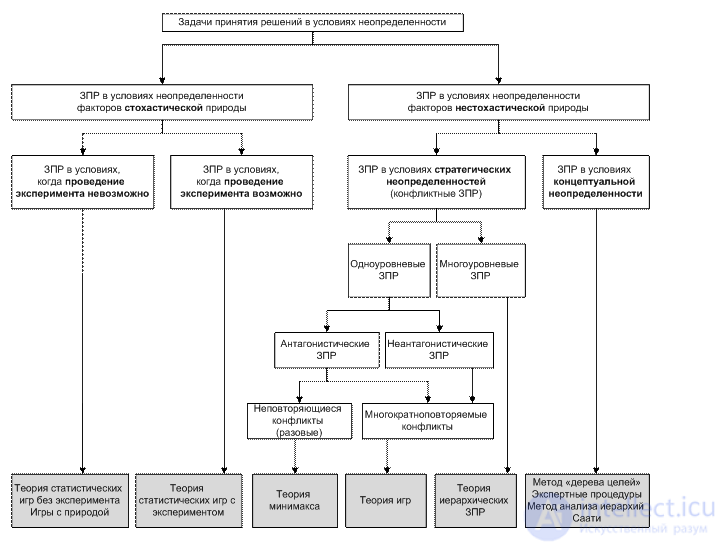Lecture
The task of decision making under uncertainty is the task of choosing the optimal strategy, the outcome of which, in addition to the strategies of the operating party and a number of fixed factors (deterministic and stochastic), depends on uncertain factors beyond the control of the operating party and unknown to it at the moment of decision making.
Due to the influence of uncertain factors, for each specific strategy (solution) there corresponds not a single outcome, but a multitude of outcomes. The specific implementation of the outcome for each decision is determined by the specific implementation of uncertain factors.
Consider the difference between fixed stochastic factors and uncertain factors . Both factors and other factors lead to a variation in possible outcomes with the repeated implementation of the same solution. This is their similarity between themselves and difference from deterministic factors. The difference is that with respect to fixed stochastic factors, the decision maker has all the complete statistical information - this information is enough to determine the probabilities of possible outcomes and decide on the choice of the optimal “average” solution. Regarding uncertain factors, the decision maker does not have such information.
In the future, we will consider the CRA under uncertainty conditions without taking into account fixed stochastic factors.
Regarding the probabilities of different outcomes, two cases are possible (Fig. 4.1):
probabilities of possible outcomes have no physical meaning - then we are dealing with uncertain factors of a non-stochastic nature ;
probabilities of possible outcomes have a physical meaning, but either the decision makers are unknown, or they are known with insufficient accuracy to make a decision - then we are dealing with uncertain factors of a stochastic nature .
The indefinite factors of a non-stochastic nature can be divided into two groups.
The first group consists of strategic uncertainty factors - uncertain factors that appear due to the participation of several operating parties in the operation. Each of the parties is forced to make decisions in conditions when it does not know the future actions of other participants in the operation.
The second group consists of conceptual uncertainty factors - uncertain factors accompanying the adoption of particularly complex decisions with long-term or far-reaching consequences. In this case, there may be fuzzy, unformalized goals (this applies, unfortunately, to a number of economic problems).
Decision making tasks in conditions of strategic uncertainty (or in conditions of a conflict situation) can be divided into single-level and multi-level ones.
In single-level decision-making tasks, the participants are not bound by any forms of subordination, they are involved in a single operation and are interested in one or another of its outcomes.
Multilevel decision making problems arise in complex control systems and have a hierarchical structure.
Single-level conflict ZDR can be antagonistic and non-antagonistic. The antagonistic interests of the two parties, pursuing opposite goals, collide.
The uncertain factors of a stochastic nature are natural uncertainties .
Natural uncertainties are uncertain factors that appear due to insufficient knowledge of the “nature”.
In TPD, the term “nature” is understood to mean the totality of circumstances under which we have to make a decision. These may be unknown characteristics of the processes associated with the course of the operation or the external conditions of the operation.

Fig. 4.1. Classification of CRA under uncertainty
Figure 4.1 presents a “tree” of decision-making tasks under uncertainty. The “leaves” of the tree explain which scientific directions in one way or another remove the uncertainty of this type. In more detail in this manual, we will focus on the CRA in the face of uncertainties of factors of a stochastic nature. When conducting an experiment is possible, we propose to consider the logical-probabilistic method (LVM); in the case when conducting an experiment is impossible, the apparatus of the theory of games with nature will help reduce uncertainty.
Comments
To leave a comment
Decision theory
Terms: Decision theory